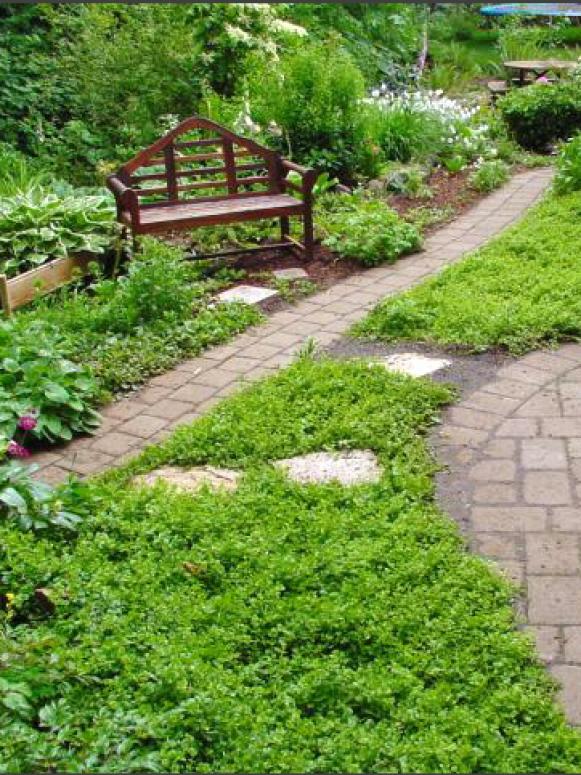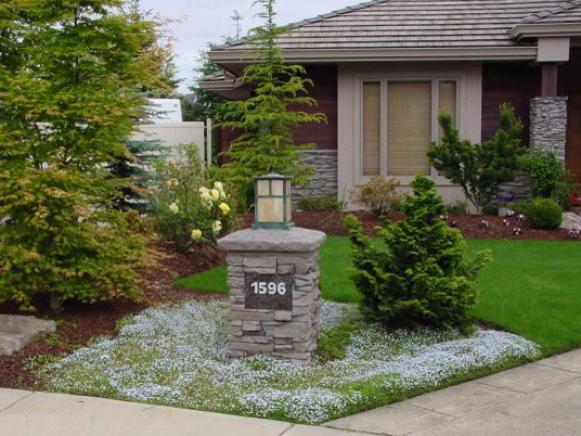
- Goose
- Cogito ergo sum
 Offline
Offline 
- Registered: 1/29/2015
- Posts: 13,427
Tired of Mowing?
Replacing Your Lawn With Landscaping
Trade in turf for groundcovers that bring low-maintenance beauty to landscapes.
Swap out your time-consuming lawn with an alternative that’s durable, easy to grow and pretty, too. Many lawn alternative plants are creeping perennial groundcovers that transform a lawn into an eye-catching tapestry of color and texture. Others are native grasses or grass-like plants, such as sedges, that function as a lawn while demanding far less care. Or maybe you’re interested in clover as a lawn supplement, if not alternative.
In today’s environmentally aware world, lawns aren’t perceived as green good guys. For instance, the American lawn guzzles water at a rate that many drought-stricken communities simply cannot sustain. In some areas of the country, replacing turf with alternative plantings qualifies homeowners for a waiver on residential storm water runoff fees that are tacked onto monthly municipal bills.
You might consider replacing portions of your lawn (such as slopes, narrow strips or oddly-shaped areas) simply because they’re a challenge to mow. Substituting a lawn alternative for turf in any of these situations instantly saves you time and money. Replacing only 25 percent of lawn area with groundcover plants yields a time and energy savings of 50 percent in mowing alone. Planting your yard’s mowing-challenged areas with a turf alternative also offers a great way to experiment with groundcovers in a small way before committing to a whole-lawn makeover.
Selecting a Lawn Alternative
When selecting a lawn alternative, consider your regional climate first and foremost. Stick with plants that survive in the typical weather conditions your area experiences. Take time to do a soil test to ensure you match the right type of plant with soil that will favor its growth. Also note the growing conditions your specific site offers: sun vs. shade and natural moisture levels. For instance, a slope tends to be drier than the base of that same slope, and a lawn area already plumbed for automatic irrigation has a ready moisture supply.
Native plants offer advantages over non-natives. They’re adapted to your region, and they’ll typically be able to withstand or even resist attacks by pests and diseases. Do your homework if you select a non-native lawn alternative. Make sure it’s not rated as invasive in your region. You don’t want to add a plant to your landscape that will overrun the turf areas you want to keep.
Words like “vigorous,” “aggressive” or “rapid” growth rate describe an advantage in a lawn alternative. It means the plant will fill in quickly and limit the time that surrounding soil is bare and open to weeds. Mat-forming lawn alternatives grow thick enough to keep weeds from gaining a foothold. Choose these types of groundcovers for spots in your yard that are highly visible.
Give your entry a makeover by replacing part of a lawn with a groundcover like blue star creeper (Isotoma fluviatilis). A smaller lawn saves time and money on lawn-maintenance chores.
Other Things to Consider
Lawn alternative plants have varying degrees of durability. Many alternatives can withstand light foot traffic, and a few can stand up to regular foot steps. Depending on where you’re replacing lawn, if you create a path through the groundcover with steppers (as seen below), you won’t have to worry about durability issues.
In regions with harsh winters, take into consideration how your lawn alternative will look during dormancy. Will plants provide any color, or do stems become bare and empty? Can foliage retain some hue during winter, or will it fade to a pale shade? Some lawn alternatives are evergreen and offer color during winter months. Others are perennials that die to the ground.
Lawns planted with more than turf typically attract more wildlife, including birds, beneficial insects and butterflies. If you intend to use your non-turf area for barefoot activities, keep in mind that flowering groundcovers will attract stinging insects. It’s a good idea to avoid using these types of plants around swimming pools or children’s play areas.
As you work to establish plants in the landscape, don’t overlook weeding and watering during the first year of growth. Follow planting instructions carefully to ensure plants develop deep roots, which will help them survive drought in future years. It’s also a good idea to cover soil with several sheets of newspaper when planting groundcovers. Tuck plants into soil by planting directly through the paper. Place two inches of mulch over the paper to reduce sprouting weeds until groundcovers establish.
A narrow, shady side yard with minimal foot traffic is the perfect place to grow Corsican mint (Mentha requienii). Add stepping stones to guide feet and protect your groundcover investment.
We live in a time in which decent and otherwise sensible people are surrendering too easily to the hectoring of morons or extremists.
- tennyson
- Exchanger
 Offline
Offline 
- Registered: 2/06/2015
- Posts: 6,654
Re: Tired of Mowing?
That all looks very nice, BUT keeping it that way can be even more work than just having an open grass area and mowing it (and easier to hire someone to do it IF that is your desire).
Nevertheless, it IS Beautiful.
"Do not confuse motion and progress, A rocking horse keeps moving but does not make any progress"
- Goose
- Cogito ergo sum
 Offline
Offline 
- Registered: 1/29/2015
- Posts: 13,427
Re: Tired of Mowing?
tennyson wrote:
That all looks very nice, BUT keeping it that way can be even more work than just having an open grass area and mowing it (and easier to hire someone to do it IF that is your desire).
Nevertheless, it IS Beautiful.
I am suspicious as well.
It is lovely. But, am I gonna really save a bunch of time on yard work that I used to spend mowing?
It looks a little too precious for that to be believable.
We live in a time in which decent and otherwise sensible people are surrendering too easily to the hectoring of morons or extremists.
- •
 1 of 1
1 of 1